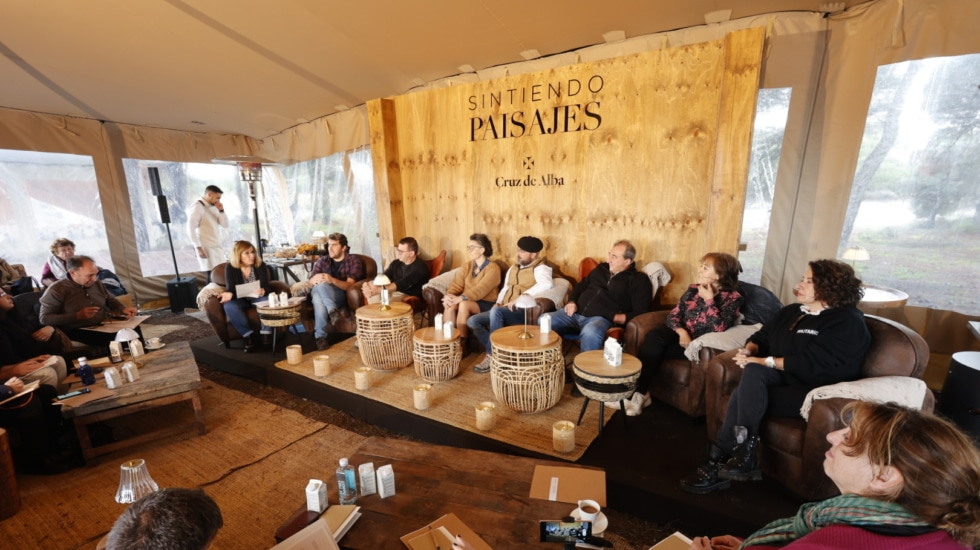

Meeting of biodynamic winegrowers “Feeling the landscapes” at the Cruz de Alba vineyard

He biodynamic wine This is a different wine. The key is his method: the farmer gives back to the land more than he takes from it, without using industrial processes or organic methods. No fertilizers or pesticides, “just” stimulating the relationship between soil and roots, between space and the leaves of the vine.
Observing and interacting with the land to transform a field into a vineyard and give it more life seems fundamental. All this has an astrological and mystical basis, held together by a collection of energies that allow you to communicate with nature, embrace it and even chew it.
“You have to eat the earth, just like when you were a child. If the earth is dissolved in the mouth, at first it is unpleasant because of the sand, but in the end, if it is living earth, a pleasant aroma remains; on the other hand, if the land is compact, you will notice the difference,” explains Federico Schatz, owner of Bodegas Schatz, at the “Feeling the Landscapes” meeting he held at the estate Wineries of Cruz de Albain the heart of Ribera del Duero, a group selected from among the leading experts in the field of biodynamic agriculture to share and compare their experiences and ideas regarding this practice.
Biodynamic agriculture
The roundtable, organized by Cruz de Alba, the smallest winery of the Zamora Company wine group, which includes brands such as Ramón Bilbao and Mar de Frades, was dedicated to “a useful and most accurate vision of biodynamic processes here and now.” Agriculture”.
One of the axis of the debate was the economic and social aspects of biodynamic viticulture, a topic that is gaining momentum in a context where sustainability and climate change are gaining relevance every day.
Receiving Demeter, a certification mark for agricultural or livestock products produced using biodynamics, raises opinions among producers, since for them their work goes far beyond the seal: “The wine must be good, and if it is also organic and biodynamic, then it must be ecological and biodynamic.” so fantastic for those who drink it,” says Pilar Higuero, grape grower, winemaker and owner of Lagar de Sabariz, who defends the certification because “people have a right to know what they’re drinking.”
For international marketing of biodynamic wine, Demeter plays a transcendental role, they note in conversation. Independent producers who emphasize their feelings: “We should not strive for elitism, but rather show the individuality of what we do. These are profitable, healthy and accessible wines,” adds Sergio Avila, director and winemaker of Bodegas Cruz de Alba.
Experts present at Sensing Landscapes believe that perceptions of biodynamic viticulture have “changed a lot” in recent years. “We’re not four flip-flop-wearing hippies and geeks anymore,” Schatz says, noting that “there are important wineries” interested in this way of making wine.
The essence of biodynamic viticulture
Roger Rovira from Recaredo (Penedes), Carmen Lopez Delgado from Uva de Vida (Toledo), Pilar Salillas from Lagravera (Lleida) and Rafa Lopez from Sexto Elemento (Valencia) also delved into the topic of relationships with the environment, climate problems, benefits biodynamics and market perception of biodynamic wines.
Carmen Lopez Delgado, with no family winemaking experience, began growing biodynamic vineyards in search of clean, chemical-free wines in 2012. Her case demonstrates two fundamental parts of Sensing Landscapes: her biodynamic journey began after an illness and now her dream is to “live off the countryside”; although not at any cost, “we cannot be in the hands of a middleman who is most interested in commercial profit, and that is why we must justify our agricultural work in the soil and in the ecosystem with the help of Demeter.”
Vineyard Cruz de Alba in Ribera del Duero.
Rafa Lopez from Sexto Elemento (Valencia), an agronomist and oenologist, comes from a family of winegrowers who stopped producing their own wine with the modernization of the countryside in the mid-20th century. Rafa puts life around his vineyard in a privileged position: “You need to understand the soil to know what the plant feeds on. The richer the soil in microorganisms, the better the wines, balance and acidity. In short, the more impressive the wines are. perfectly convey the essence of the place.
Pilar Salillas, CEO and winemaker of Lagravera, delves into the fact that “agriculture is the best lesson in life and forces us to constantly adapt.” Director Lagravera hints at the need to use applications to save the vineyards, because “no year is the same and new situations always arise,” but, as biodynamics dictates, “it is not necessary to resort to chemical products. Just understand and adapt.” “.
Recadero spokesman Roger Rovira on the difficulty of translating biodynamic work into certification: “Much of biodynamics is intangible, especially what we don’t see. How are you going to certify your way of understanding life and your relationship with improvement? The best part is that people come to the winery and feel it. “Let them taste the wine,” emphasizes Schatz, and concludes: “Management is the most important thing in the vineyard. Wine is not made in the winery, it must be in the field.”
In Spain, biodynamic viticulture accounts for 20% of total biodynamic crops, with 2,500 hectares and 61 operators. According to Demeter, this area represents about 10% of the world’s total area.
Source: El Independiente